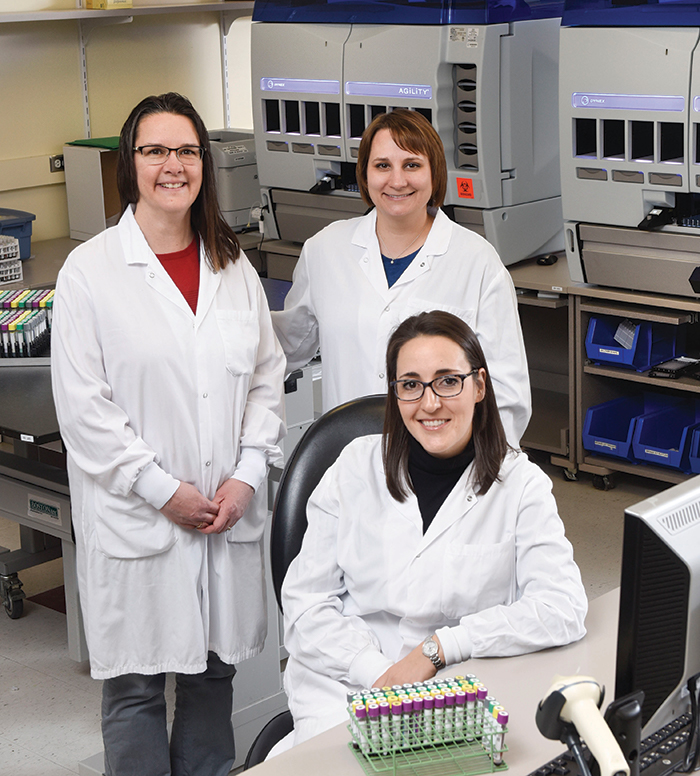Karen Titus
April 2018—Scratch the surface of TB testing, and things quickly get interesting.
The standard skin reaction test, widely adopted by the early 1940s, is still in use today. The goal has remained steady as well: break the transmission cycle. “From the clinician perspective and the laboratory perspective, because of its infectious nature, we want to identify people with latent tuberculosis,” says Elitza Theel, PhD, lab director for the infectious disease serology laboratory, Mayo Clinic and Mayo Medical Laboratories. “The ultimate goal is to treat them, so they don’t progress to active TB.”

Mayo Clinic began offering the QuantiFeron-TB Gold Plus in February, a switch that required logistical juggling, say Dr. Elitza Theel (seated), Lori Misner (left), and Heather Hilgart. “Pay attention to all impacted areas,” including phlebotomy, Dr. Theel advises other labs.
If Dr. Seuss were weighing in at this point, the tale might read something like this:
Old test, One test, Two test, New test!
But the story is far from over, given the estimated 13 million residents in the U.S. with latent TB infection. Among those, about five to 10 percent will develop TB if they don’t receive treatment. So what lies ahead?
Several changes are in the works.
One was a recently updated treatment guideline from the American Thoracic Society, Infectious Diseases Society of America, and Centers for Disease Control and Prevention that calls for stratifying patients into three groups based on risk of progression: high risk, low to intermediate risk, and unlikely to progress or to have TB.
A second is Qiagen’s move to a fourth-generation assay. Like other earlier IGRAs, the Plus test (as it’s generally known) detects CD4 T cell response. But the newer test also detects CD8 T cell response, an addition many hope will prove beneficial on several fronts.
Finally, the CDC in February sent out a notice that it plans to change medical screening guidelines for immigrants, effective Oct. 1, calling for the use of an FDA-approved IGRA for TB screening, including children under age five.
All these moves will likely nudge laboratories in new directions.
Even before the CDC announcement, some health care providers had begun to move away from the skin test, says Dr. Theel, who is also co-director of vector-borne diseases laboratory services and associate professor of laboratory medicine and pathology, Mayo Clinic. Specificity can be a problem with the skin test, she notes, and it can be falsely positive in individuals who have undergone BCG vaccination or if the test was administered or interpreted incorrectly. And sensitivity, particularly in patients who are immunosuppressed or in very young children, can be lower.
For annual health care employee screening, many institutions are making the switch from skin testing to an IGRA as well, says Dr. Theel, who reports seeing this among Mayo’s reference lab clients. Collectively, she says, referring to Mayo’s reference lab testing and its own patient population, which includes a large number of patients from TB endemic areas, “we performed over 90,0000 QuantiFeron tests last year.”
About an hour and a half up the road, in Minneapolis, Glen Hansen, PhD, D(ABMM), is also wrestling with a diverse patient population at risk for TB. As the medical director of clinical microbiology and molecular diagnostics at Hennepin County Medical Center, he oversees a high volume of TB testing. “We have a big refugee screening program here, and the hospital supports a public health TB clinic.”
As for employee health care screening, he says, the first question to ask is what percentage of the institution’s workers are foreign born. “Our hospital,” he notes, “continues to have and staff a fairly diverse group of people.” Many of these people are unlikely candidates for the skin test because they’ve received the BCG vaccine.
While some institutions are deciding to move to less-frequent worker screenings, he adds, that’s not the case at Hennepin. “We continue to see a fair amount of active TB cases at our hospital. So yearly screening is still something we feel strongly about.”
While the winds appear to be shifting in favor of IGRAs and, in the case of those who use the QuantiFeron assay, toward the Plus test, diagnostic complexities remain. Michael Wilson, MD, puts it this way: “It’s critical that you understand the strengths and weaknesses of the test you’re using because there aren’t a lot of options.”
Dr. Wilson is well versed in both skin testing as well as IGRAs. “We currently use the QuantiFeron Gold assay and are moving soon to the Plus assay for high-risk patient populations,” says Dr. Wilson, director, Department of Pathology and Laboratory Services, Denver Health Medical Center. “But we use skin tests for low-risk populations. Which test to use depends on the patient population.” The skin test is used for annual and new employee screening and other populations at low risk for TB.
 CAP TODAY Pathology/Laboratory Medicine/Laboratory Management
CAP TODAY Pathology/Laboratory Medicine/Laboratory Management
